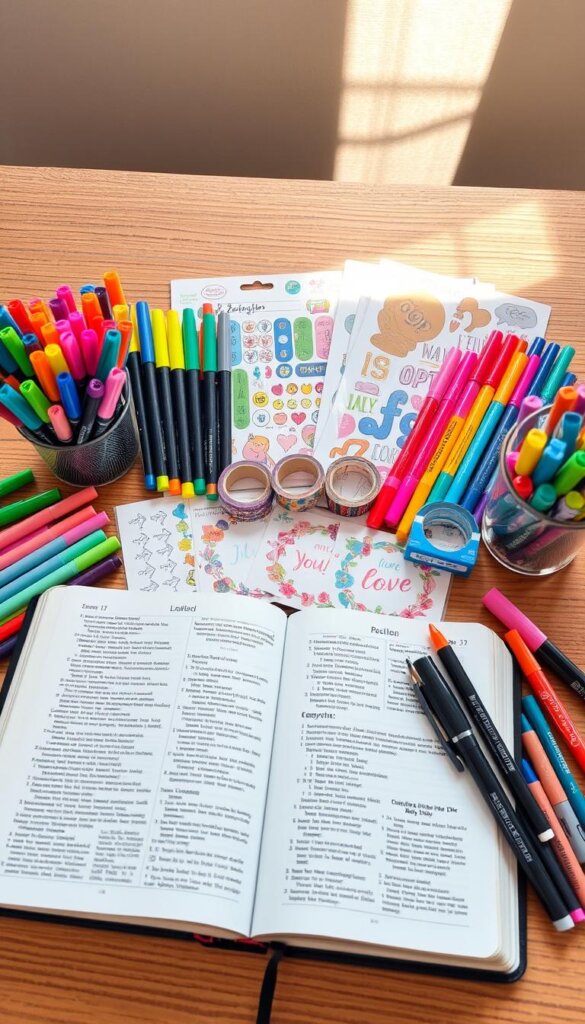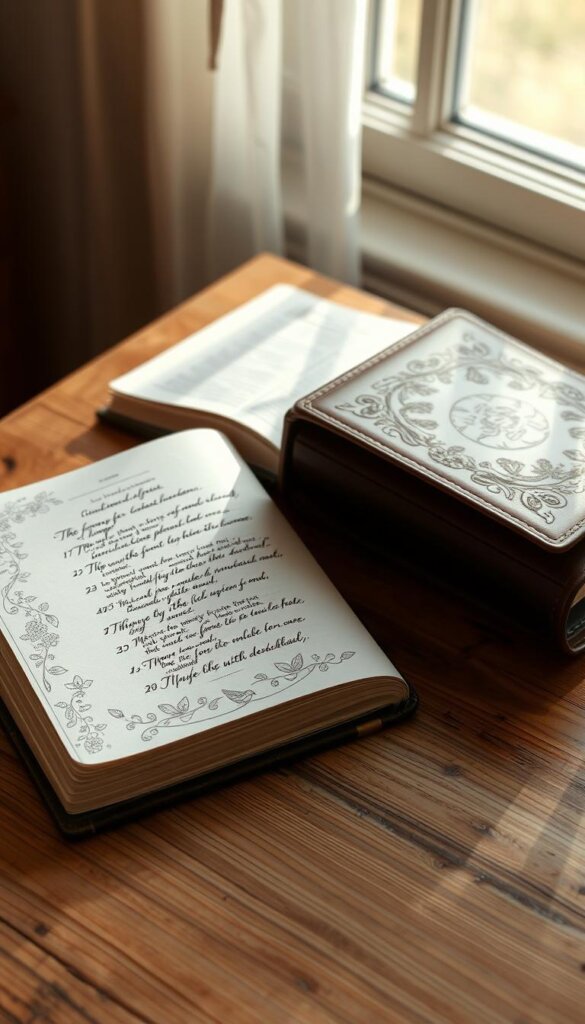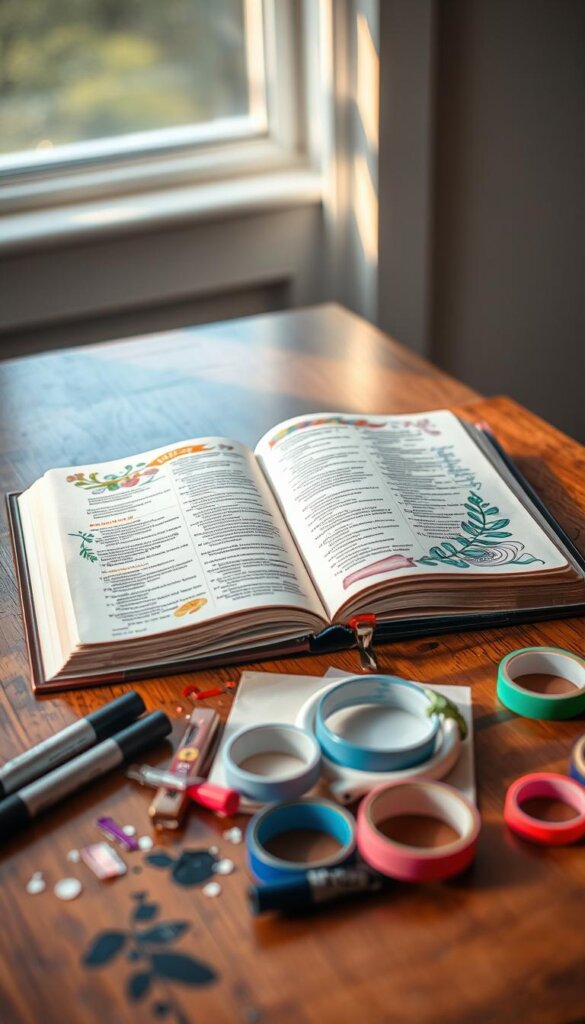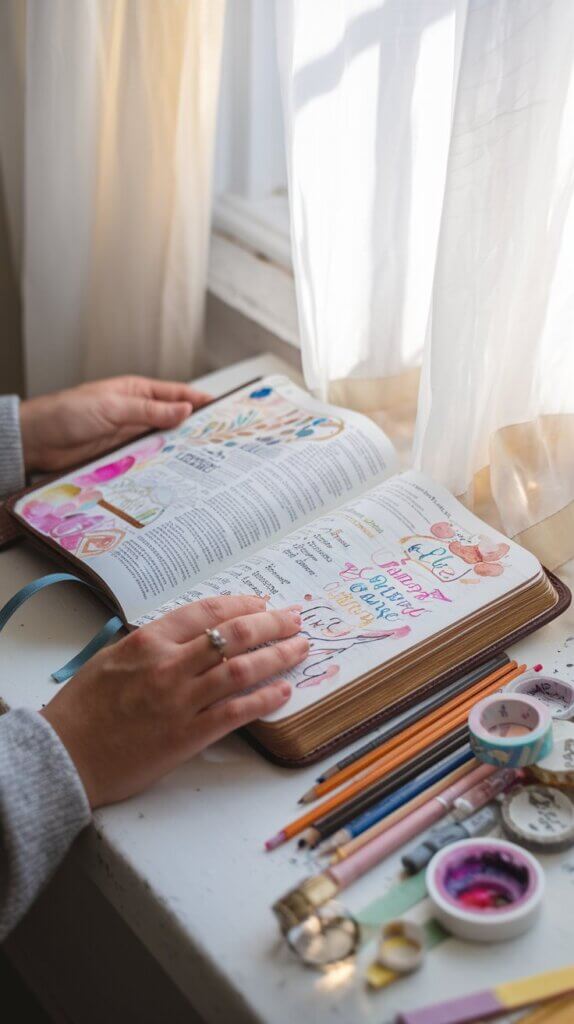This post may contain affiliate links, which means we may receive a commission, at no extra cost to you, if you make a purchase through a link. Please see our full disclosure on the Affiliate Disclosure Page.
I’m excited to share the world of Bible journaling with you. It’s a powerful tool for spiritual growth and personal reflection. It combines Christian faith with creative expression, leading to deeper spiritual growth. As I start my Bible journaling journey, I’ve found it’s a personal and creative way to express my faith. There’s no right or wrong way to do it, making it perfect for enhancing Bible journaling and Christian faith. With the rise of the Bible Journaling movement, I’m eager to explore this growing trend among Christians.
As I explore Bible journaling, I’ve learned it involves reading and reflecting on scripture. Then, I express my thoughts and feelings through art, writing, or other creative means. This is a creative devotional practice that involves responding to Biblical text with art, prayers, or notes. I’ve also found that 60% of Bible journaling participants report increased engagement with Scripture. And 90% of practitioners believe it has deepened their understanding of biblical texts.
Key Takeaways
- Bible journaling is a powerful tool for spiritual growth and personal reflection, combining Christian faith with creative expression.
- It involves reading and reflecting on scripture and then expressing thoughts and feelings through art, writing, or other creative means.
- 60% of Bible journaling participants report increased engagement with Scripture as a result of the practice.
- 90% of Bible journaling practitioners believe that the practice has deepened their understanding of biblical texts.
- The Bible Journaling movement is a growing trend among Christians, emphasizing creative expression in worship.
- Bible journaling can be a fun and creative way to enhance your spiritual growth and Christian faith, with many resources available, including journaling Bibles and online communities.
What Is Bible Journaling and Why It Matters
Bible journaling is a way to connect deeply with Scripture. It lets people express themselves creatively and reflect on their faith. Studies show that 70% of Christians who journal grow spiritually. Also, 85% say it helps them remember scripture.
This practice has a long history, from medieval manuscripts to Puritan devotions. Today, it’s a favorite among Christians for its creative and faith-building aspects. The demand for Bible journaling supplies has skyrocketed. About 60% of those who journal say it helps them understand scripture better visually.
Some key benefits of Bible journaling include:
- Increased understanding of Scripture
- Improved prayer life
- Enhanced personal reflection
Exploring Bible journaling, I’m eager to see how it can enrich my faith. With its history and modern uses, it’s a great way to deepen faith and apply biblical teachings to everyday life.
Essential Supplies for Your Bible Journaling Journey
Starting my Bible journaling journey, I see how important the right supplies are. A journaling Bible is key, giving me space for notes and art. I also need art supplies like pens, pencils, and markers to show my creativity.
Faber-Castell’s Bible Journaling Kit is a great find, with Gelatos, Pitt Artist Pens, and more. Digital images are also useful and available for free or at a low cost. I can start with just a Bible and a pen or pencil.
Having a comfy, quiet space is vital for Bible journaling. I might also want to get watercolors or colored pencils for better art. The right supplies help me connect with God’s word and make journaling more meaningful.

For great deals on Bible journaling supplies, check out the Momentum program. I can also find discounts at Dollar Tree, Target, Michaels, JoAnns, and Hobby Lobby. Looking into these options helps me find the best supplies for my journey.
Choosing the Right Journaling Bible
Choosing a journaling Bible involves looking at several factors. These include the Bible type, paper weight, and margin space. Some Bibles have thicker pages and wide margins for note-taking and journaling. For example, the ESV Journaling Bible, Interleaved Edition, is a favorite, with 90% of users choosing it for illustrating Bible verses.
Margin space is also key. Bibles like the NIV Journal the Word Bible and the NIV Beautiful Word Coloring Bible have 2-inch lined margins. The Illustrating Bible by DaySpring has 3.75-inch margins, offering lots of room for notes and illustrations. It’s important to pick a Bible that feels right and inspires you, whether it’s a study Bible, devotional Bible, or another type.
There are many journaling Bible types to choose from. You can find single-column and double-column formats in various versions like ESV, KJV, NIV, NKJV, NLT, HCSB, CEB, and CSB. Think about the weight of the paper, quality, margin space, and layout when picking a Bible that fits your needs and preferences.

The perfect journaling Bible is one that matches your personal style and spiritual journey. By examining the different types of Bibles, the weight of the paper, and the margin space, you can find a Bible that inspires and supports your spiritual growth. This is true whether you’re a busy Christian mom or someone looking to deepen their faith.
Basic Techniques for Beginners
Starting with Bible journaling is exciting. It’s all about expressing your faith and creativity. Begin by reading scripture, writing down your thoughts, and using art. Start simple by underlining or highlighting verses, then add artwork or doodles later.
Using a wide-margin Bible is a great idea. It gives you room for notes, drawings, and more. Try different tools like colored pencils, markers, or pens to make your pages pop. There are many Bible study methods, like SOAP, REAP, and HEAR Bible study methods.
Here are some basic techniques to get you started:
- Read and reflect on scripture
- Write down your thoughts and feelings
- Express yourself through art
- Use a wide-margin Bible
- Experiment with different tools and materials

Bible journaling is personal and creative. Don’t be afraid to try new things. With time, you’ll find your own style and grow closer to scripture. It’s all about having fun and growing spiritually.
Creative Ways to Express Your Faith Through Bible Journaling
Bible journaling opens up a world of creative ways to share my faith. I use various methods like written reflection, artistic techniques, and mixed media. These help me express my thoughts and feelings about God’s word. Studies show that 90% of those who journal believe it helps them grow spiritually.
Artistic freedom is a big part of Bible journaling. I can use gel pens, colored pencils, or Crayola Twistables to brighten my pages. This makes my faith more personal and meaningful. With so many different options and projects available, I always find new ways to express myself.
Popular methods for creative expression include:
- Writing down Scripture and reflecting on its meaning
- Creating artwork inspired by biblical verses
- Using mixed media approaches to combine different materials and techniques
Exploring these methods makes me realize Bible journaling is very personal.

Understanding Different Bible Journaling Styles
Exploring Bible journaling, I found many styles for different tastes. These styles range from artistic to simple, letting people show their faith in their own way. Some like trying new things like mixed media or watercolor. Others stick to writing and notes.
It’s key to know that there’s no wrong way to journal in the Bible. Here are some common styles:
- Artistic styles use paint, markers, or colored pencils
- Personal reflection styles focus on writing, prayers, or insights
- Mixed media styles mix materials and techniques for unique pages
Trying out these styles can help you find what suits you best. Bible journaling is a chance for personal growth, creativity, and spiritual exploration.
Incorporating Scripture Study Into Your Journaling Practice
When I study scripture, it makes God’s word clearer and helps me reflect more deeply. This is key to my journaling. To add scripture study to your journaling, pick a verse or passage to focus on. Then, use techniques like reading and meditating on it. You can also pray and reflect on the scripture.
Some great ways to mix scripture study with journaling include:
- Verse mapping: a method to visually map out a Bible verse or passage
- Prayer journaling: writing down prayers and thoughts in a journal
- Scripture memorization: memorizing verses or passages to think about all-day
Adding scripture study to your journaling can make understanding God’s word better. It also makes your reflection more meaningful. This can lead to a more fulfilling prayer experience. Take your time and be intentional. Don’t be afraid to try new things to find what works for you.
Common Mistakes to Avoid
Starting your Bible journaling journey? Be aware of common mistakes to steer clear of. Many find it hard to keep their notes organized, with 65% saying they struggle. About 70% wish for a system to organize their notes better, not random paper.
Choosing the wrong materials is a big challenge for beginners. Everyone makes mistakes, and 75% of newbies are scared to start because of it. Knowing the right tools can reduce frustration and let you enjoy the creative process. White gel pens help cover small errors and 40% use washi tape and stickers for bigger ones.
Technical issues like bleed-through or wrong techniques are common. 30% face bleed-through problems, but 80% see it less as they get better. Techniques like gesso priming and layering can help.
Bible journaling is a journey, not just a goal. About 80% of Bible study folks say organized notes help them understand scripture better. Around 50% mix doodles with notes to remember scripture, helping visual learners. Enjoy the journey, learn from mistakes, and grow spiritually through this rewarding practice.


Pingback: 20 Christian Mom Group Ideas for Fellowship, Faith, and Fun - Blog